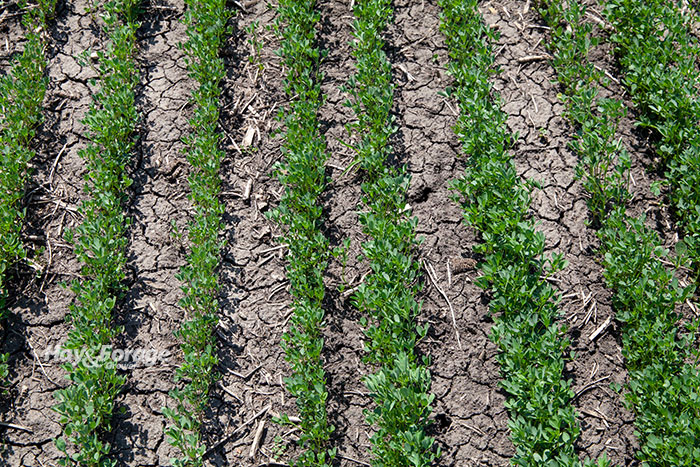Good alfalfa starts with good establishment |
| By Mike Rankin, Managing Editor |
|
|
 Perhaps the weakest link in the entire alfalfa production cycle is getting a healthy, vigorous stand. Subsequent production, forage quality, and persistence hinge on it. During a “Field Crops Virtual Breakfast” webinar last week, Kim Cassida outlined what is needed to successfully establish alfalfa. To begin, the forage extension specialist with Michigan State University suggested there were some essential factors that needed to be met before drills or seeders hit the field. They are: • A well-drained, fertile site • A soil pH greater than 6.5 (6.8 ideal) • A soil phosphorus and potassium test that is in the moderate range (these nutrients can be applied at planting) • No autotoxicity concerns (no alfalfa growing in the field the previous year) • A soil that is free of residual broadleaf herbicides from a previous crop • For no-till: a minimum amount of surface residue • The selection of a top-performing alfalfa variety with disease resistance Specifically addressing autotoxicity, Cassida said that alfalfa is toxic to its own seedlings, which is unique among major field crops. “If you replant too soon, the resulting stand may not establish or suffer from autosuppression, which reduces lifetime productivity due to root damage,” she explained. “This autotoxic effect is also the reason why you can’t successfully interseed alfalfa back into an existing alfalfa stand.” Cassida recommends waiting at least six months to one year before alfalfa is established in the same field. She is currently developing a bioassay to identify the potential toxicity of specific fields so that farmers can have the ability to know the toxicity risk before they seed. Not too early, not too late There are two windows for seeding alfalfa in the Midwest: spring and late summer. Spring seedings allow for one or two cuttings during the seeding year. “If you plant too early in the spring, there is more risk for subsequent freeze damage and seedling diseases in cold, wet soils,” Cassida said. “Planting too late can set up fields for greater weed and potato leafhopper pressure along with a higher likelihood of dry soil conditions.” The longtime forage specialist suggested that if spring seedings get delayed too long, it might be better to wait until late summer to establish a new field. In Michigan, she doesn’t recommend seeding alfalfa from June through mid-July. A late-spring frost or freeze can put young alfalfa stands at risk. Cassida said that alfalfa seedlings have good cold hardiness except for a sensitive period between the two to three trifoliate leaf stage. During these stages of growth, it only takes about four hours of temperatures below 24°F to kill seedlings. “The air temperature is not always the same as ground-level temperatures, which can be uneven across a field,” Cassida explained. “Low areas and north or west-facing slopes tend to be the coldest.” Companion crop decisions A companion or “nurse” cereal crop such as oats will help protect the young alfalfa seedlings from frost damage and helps to crowd out weeds. “Harvest your nurse crop no later than the boot stage or spray it out when it reaches about 6 inches tall,” Cassida said. “The cereal grain needs to be planted at a low rate along with a full rate of alfalfa. Applying 30 to 40 pounds of nitrogen per acre can boost the nurse crop’s performance if it’s harvested for forage,” she added. Cassida recommends seeding 12 to 20 pounds of pure live alfalfa seed per acre, depending on location, seed coating percentage, and planting conditions. She said this should result in 20 to 30 seedlings per square foot at the end of seeding year. “There is no research to support higher seeding rates,” Cassida asserted. “As seeding rates go beyond the recommended maximum, more seedlings will fail. Further, higher seeding rates don’t translate to improved forage quality.” Monitor seeding depth “Alfalfa is a persnickety plant,” Cassida asserted. “Seedlings cannot emerge from deep in the soil. We recommend a seeding depth of one-quarter to one-half inch. This is sometimes more difficult to accomplish with no-till seeding when there is excessive plant residue. On sandy soils, a slightly deeper seeding depth — up to 1 inch — is possible.” Concluding, Cassida noted that it’s ideal if about 10% of the seed is on top of the ground after seeding. “If you don’t see this, then there is a good chance that you’re seeding too deep.”
|
